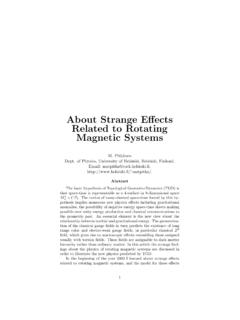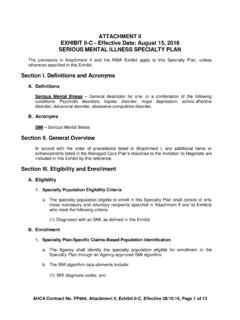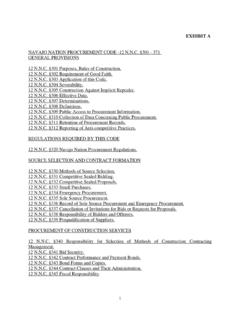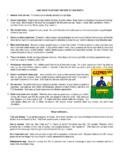Transcription of Composite fermions and bosons: An invitation to electron ...
1 Proc. Natl. Acad. Sci. USA. Vol. 96, pp. 8821 8822, August 1999. From the Academy This paper is a summary of a session presented at the first Japanese-American Frontiers of Science symposium, held August 21 23, 1998, at the Arnold and Mabel Beckman Center of the National Academies of Sciences and Engineering in Irvine, CA. Composite fermions and bosons: An invitation to electron masquerade in Quantum Hall YASUHIRO IYE*. Institute for Solid State Physics, University of Tokyo, Roppongi, Minato-ku, Tokyo 106-8666 Japan; and CREST, Japan Science and Technology Corporation, Mejiro, Toshima-ku, Tokyo 171-0031 Japan ABSTRACT The two-dimensional electron gas formed at the semiconductor heterointerface is a theater for many intriguing plays of physics.
2 The fractional quantum Hall effect (FQHE), which occurs in strong magnetic fields and low temperatures, is the most fascinating of them. The concept of Composite fermions and bosons not only is beautiful by itself but also has proved highly successful in providing pictorial interpretation of the phenomena associated with the FQHE. Elementary particles are classified into bosons and fermions . The distinction is made on the basis of the symmetry of their FIG. 1. (a) Clockwise and counterclockwise exchange operations wavefunction upon particle exchange. In quantum mechanics, are distinct in two dimensions.
3 (b) The way the phase of the wave- the physical state of a group of particles is represented by a function is changed upon particle exchange can be altered by attaching wavefunction (r1, r2, , rN), where ri represents the position a fictitious flux to each particle. of the ith particle. As the identical particles are indistinguish- able, exchange of two particles changes the wavefunction at phase change upon particle exchange. If the path encloses a most by a factor C, , ( rj, ri, ) C ( ri, rj, ). Doing single flux quantum 0 h e, the above-mentioned extra the two-particle exchange twice brings the system back to the phase is , so fermionic electrons can be formally converted to original situation, so that C2 1, and hence C 1.
4 The bosons. This trick can be applied to every electron if each choice of the sign of C is intimately linked to the spin quantum carries an odd number of fictitious fluxes of unit flux quantum. number of the particles, namely, particles having an integer Likewise, attaching an even number of unit fluxes converts spin quantum number take C 1 and are called bosons, fermions to fermions and bosons to bosons. Such particles with whereas those with a half-odd spin take C 1 and are called fictitious fluxes attached are called Composite particles (com- fermions . This can be expressed by writing C ei , in terms of posite fermions and Composite bosons).
5 The change in the phase of the wavefunction by 0 or (mod The idea of Composite particles has evolved from the study 2 ) upon particle exchange. fermions and bosons exhibit quite of the quantum Hall effect. The phenomenon occurs in a 2D. distinct types of behavior at low temperatures. Bosons, for electron gas (2 DEG) at the semiconductor interface subjected example, undergo Bose Einstein condensation and become a to a strong magnetic field at low temperatures. The quantum superfluid. Hall effect was discovered in 1979 in Si-MOS (metal-oxide- Electrons having spin 1 2 are fermions . In our three- semiconductor) devices and was subsequently observed in dimensional (3D) world, the distinction between fermions and GaAs AlGaAs HEMT (high electron mobility transistor).
6 Devices. bosons is strictly enforced. In a two-dimensional (2D) world, When 2D electrons are subjected to a vertical magnetic field, however, the rule can be relaxed by a trick called flux their energy states are quantized to a series of discrete levels attachment. One can transform a fermion to a boson (or vice called Landau levels. Each Landau level can accommodate up versa) by attaching to it fictitious magnetic flux(es), which to eB h 1 2 2 ( eB) electrons per unit area. The takes care of the change in the phase of its wavefunction. The electron density divided by this quantity gives the number of reason why this sort of trick works lies in the following feature Landau levels occupied by electrons, and is called the filling of particle exchange operation in the 2D world.
7 When we factor . The filling factor is the ratio of the number of exchange two particles in two dimensions, clockwise and electrons to the number of flux quanta. counterclockwise exchange operations are distinct, as shown in The salient features of the quantum Hall effect (QHE) are Fig. 1. In three dimensions, by contrast, they are not distin- as follows: (i) the Hall conductivity xy as a function of guishable, because one can be transformed into the other by a magnetic field exhibits plateaus at around integer values of ;. continuous transformation of the exchange path. This is linked (ii) the values of the Hall conductance at the plateaus are.
8 To the fact that winding number is a conserved quantity in two (integer) times the universal constant e2 h ( ) 1;. dimensions, but not in three dimensions. and (iii) the longitudinal conductivity xx vanishes concomi- If we imagine that there is a fictitious vector potential field tantly. That a quantity such as conductivity which generally a(r), an electron picks up an extra phase, (e ) path depends on many parameters of a particular sample takes a a(r) d as it moves along the path. This phase adds to the universal value was a big surprise. The physical origin of the fermionic ( ) or bosonic (0) phase, and it can alter the overall *To whom reprint requests should be addressed.
9 E-mail: PNAS is available online at 8821. 8822 From the Academy: Iye Proc. Natl. Acad. Sci. USA 96 (1999). phenomenon is explained in terms of electron localization in a random potential (Anderson localization). The phenomenon is now called integer quantum Hall effect (IQHE), to distin- guish it from fractional quantum Hall effect (FQHE), which was discovered a few years later. The FQHE is similar to the IQHE, except that it occurs at fractional values of , such as 1 3, 2 3, 2 5. electron electron interaction plays an essential role in the FQHE. In a strong magnetic field such that all electrons are accommodated in the lowest Landau levels, the kinetic energy of electrons is quenched so that the electron electron interaction becomes important.
10 At a series of fractional values of filling factor with odd denominators, the electrons take special configurations that are particularly effective in minimizing the repulsive Coulomb interaction. Fig. 2 shows the Hall resistivity xy and longitudinal resistivity xx of a high- quality GaAs AlGaAs 2 DEG sample. The FQHE features at 1 3, 2 5, 3 7, .. and 2 3, 3 5, 4 7, .. show up strongly. The wavefunction describing the 1 state is written as FIG. 3. Schematic drawings of the 1 and 1 3 states. 1 z 1, z 2, .., z N . i, j . z i z j exp . i . z i 2 4 2 , 1 3 z 1, z 2, .., z N . z i z j 3exp.







